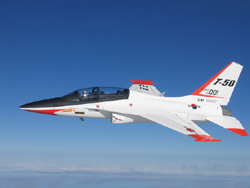Building a Base to Develop Supersonic Aircraft
 Korea Aerospace Industries was born in October 1999 in response to the need for Korea to have its own competitive aerospace industry to prevent double investments and a split of the development technologies as well as to reduce the trade deficits in aerospace equipment, which came to $25.1 billion during 1990 and 1996, the largest amount for a single industry.
Korea Aerospace Industries was born in October 1999 in response to the need for Korea to have its own competitive aerospace industry to prevent double investments and a split of the development technologies as well as to reduce the trade deficits in aerospace equipment, which came to $25.1 billion during 1990 and 1996, the largest amount for a single industry.
The company's goal is to be a total solution provider in the aerospace field by 2020, as stated in the vision statement, which reads, "We, as a core force in the challenging and creative corporate culture will grow to be a total solution provider in the aerospace industry, meeting its entire responsibility as a global player by 2020."
The company's main business area is the development, production and training system completion of aircraft for military and civilian uses. The company has decided to promote its objectives step-by-step. KAI has developed and produced the KT-1 and T-50 trainer aircraft and has both exported them and sold them domestically for civilian use, securing a core growth power to advance into the world market for aircraft under its new "10/10" objective.
KAI aimed at selling 90 billion won worth of KT-50s, KHPs and other equipment for military use and expanding the civilian market for those planes. The civilian portion of total sales accounted for 36 percent in 2008. By 2011, the annual sales of complete airplanes and large airplanes to be developed jointly with international aircraft makers will amount to 1.7 trillion won with the civilian share taking up 50 percent. By 2020, KAI's sales will amount to 3.5 trillion won with domestic sales accounting for 60 percent of annual sales, centered around mid-sized aircraft, T-50s and KUH helicopters.
KAI, since its establishment in 1999, has manufactured the KF-16 with imported technologies, followed by the production of the KT-1 basic trainer aircraft and the T-50 high-level training airplane as well as the successful undertaking of other large national projects.
KAI made Korea the 12th country in the world with a supersonic aircraft, with its technologies recognized by such world-class aircraft makers as Boeing and Lockheed. KAI obtained the CMMI Level III certificate for the first time as a defense industry company in the country. CMMI stands for Capability Maturity Model Integration, a certificate for the capacity to develop international software.
With the certificate in hand, KAI expanded its business areas to capacity improvement (P3 marine surveillance aircraft) from the Korean-type helicopter production. The company is now engaged in exports of KT-1 and T-50 aircraft and large civilian aircraft (A350 and others) to be jointly developed with international aircraft makers.
In the area of fixed wing aircraft, KAI is engaged in the development of an unmanned surveillance aircraft (UAV), among others. In the area of rotary wing aircraft, KAI is working on 9-passenger and 7-passenger helicopters for civilian use, in addition to the KHP. In the area of airplane body structure production, the company is engaged in the joint production of the tail wing for the B-737 aircraft, the body part of the Apache helicopter, multipurpose practical satellites Nos. 1 and 2 and the development of a civilian passenger aircraft with international aircraft makers.
With the T-50 high-level training aircraft, KAI is considered to have made a great contribution to the strength of national defense, especially in the area of security technology capacity, and building a base for independent development capacity for a high-tech fighter plane. KAI also saved some $900 million in the cost of purchasing similar aircraft from overseas.
KAI has also brought Korea into the international club of countries with the capacity to produce high-caliber aircraft, breaking out of its habit of relying on foreign imported technologies to build aircraft in the '90s, and is entering the age of developing its own aircraft, including supersonic aircraft with its own technologies, becoming the 12th nation to do so.
With a sustained drive to build the capacity and base to develop its own supersonic aircraft, KAI has provided the aircraft industry with the opportunity to be a futuristic export growth industry. nw
A T-50 supersonic trainer to come out of the mass production line of the airplane by KAI.
3Fl, 292-47, Shindang 6-dong, Chung-gu, Seoul, Korea 100-456
Tel : 82-2-2235-6114 / Fax : 82-2-2235-0799